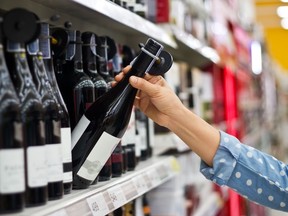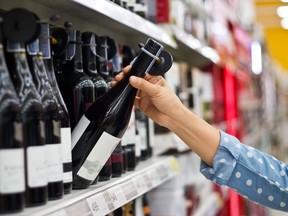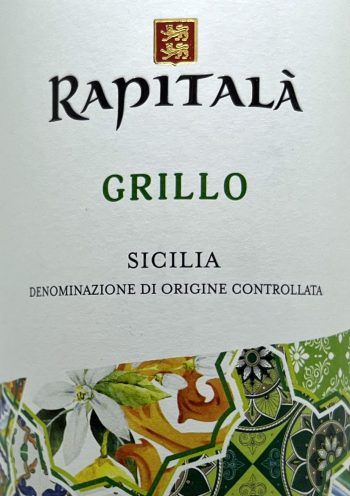Reviews and recommendations are unbiased and products are independently selected. Postmedia may earn an affiliate commission from purchases made through links on this page.
One glass at a time a good strategy for floundering business of wine

‘Wine has been around for 6,000 years and has taken a lot of hits along the way, so I’m not worried that it will disappear’

Article content
English writer Harry Eyres has written the weekly wine column in Country Life magazine since 2015 and a regular column — L’Ame du Vin — in The World of Fine Wine. He recently wrote a piece for U.K.-based timatkin.com worrying about the future of wine, and so am I. Eyres wrote, “The anti-wine forces are massing and strengthening in a way I haven’t experienced in my lifetime. Until very recently, seeing a seminar advertised on The Future of Wine, I would have assumed the major threat was climate change.”
Advertisement 2
Article content
He points out the apparent paradox: “The existential threats to wine are gathering as wine celebrates a golden age of sophistication and beauty.” Eyres points to medical squadrons as the vanguard of the attack led by the chief medical officers of the U.K. and the World Health Organization. I would add the anti-alcohol movements in North America that would like you to think that no level of alcohol consumption is safe for your health, and they back it up with a lot of sketchy information and fierce lobbies whose real motivation is unknown.
Meanwhile, writers and, in particular, tasters and critics who have made wine a lifelong study are being marginalized in favour of social media influencers who are highly compensated to suggest their clients’ wine, shoes, underwear, bubbly water, and (fill-in the blank) are the in thing. For newcomers to wine, this is a lot to take in and enough to make you reach for anything but wine to drink, and you are.
Every other article written about wine says the “wine business is in big trouble.” Sales and profits are falling, and most of the story centres on the inability of wineries to connect with the modern consumer. I have a different thought. It’s not the wine business that’s in trouble; it’s the business of wine that is floundering.
Advertisement 3
Article content
Large commercial wineries, massive distributors, and giant retailers have slowly taken over the wine business, driving off or undercutting wine’s longtime champions and storytellers: small independent wineries, distributors, retailers and traditional wine writers. The result is a flood of low-quality, overpriced, no-name brands that offer none of the experience the under-30 crowd says it craves.
To wit, B.C. government stores list 860 wines under $20, but I would need help to recommend more than 20 as worth drinking. Put those heavily taxed wines in a restaurant, and what is sold ex-cellars at the winery for about $5 is suddenly on a wine list for $65. Hence, there is a rush to cocktails and beer or shunning restaurants altogether. Local wineries have vastly improved their wines and, in many cases, have achieved parity. However, with few interesting low-priced imports for competition, they have been free to price their wines at higher retail prices, further shrinking the buyers pool.
This leads us to the elephant in the room. Wine is far too expensive for what you get and, in many cases, for what people want — a decent glass of drinkable wine that entices the senses and adds to the meal and conversation.
Article content
Advertisement 4
Article content
Wine has been around for 6,000 years and has taken a lot of hits along the way, so I’m not worried that it will disappear, but I am curious as to how it will survive the current crisis. When I started paying attention, I was spurred on by writers Harry Waugh and Gerald Asher, who wrote about the magic of wine, the people who made it and where it came from. It was half travelogue, one-quarter people and one-quarter technical. In many ways, they were the first influencers to touch the public, one book and one winery at a time.
I know the world has moved on, and we can’t go back, but one glass at a time might be a strategy we could all embrace if we still want to enjoy wine for the next 6,000 years.
Weekend wine picks

Garzón Albariño Reserva 2023, Garzón, Maldonado, San José, Uruguay
$24.95 I 91/100
UPC: 7730951080112
Albarino has been the Garzon flagship white since the first year it was released, and seven years later, it is the No. 1-selling white wine in Uruguay. The colour has a brilliant pale yellow-green tint while the nose is highly expressive, reflecting its position as a short drive inland from the cold Atlantic Ocean. Everyone involved in the project thinks 2023 is the best-ever release of the Garzon Albarino, crammed full of light peachy notes drenched in citrus pith with a full stony mineral finish. Lip-smacking and lively, this was made for B.C. seafood. Finally, it will be available year-round in B.C. liquor stores for $24.95.
Advertisement 5
Article content

Quails’ Gate Dijon Clone Chardonnay 2022, Okanagan Valley
$39.99 I 92/100
UPC: 78856422016
At Quail’s Gate, they describe the inaugural vintage of the ’22 Dijon Clone Chardonnay as a thoughtful blend of clones 96, 95, 76, and 548, carefully hand-selected from premium South Kelowna vineyard blocks. It is all hand-picked, whole-cluster pressed, and barrel fermented in French oak for 15 months, and it goes through complete malolactic fermentation with some battonage, adding to the wine’s smooth, creamy character. There is excellent ripeness here with a honeyed peach flavour mix with flinty streaks that permeate the entire wine. The finish is clean and mineral-driven with a stony finish — so impressive and another step up for Chardonnay at this winery. The winery likes several cheese matches: Swiss fondue, Gouda panini or French onion soup. Super value.

Château Daviaud 2020, Bordeaux, France
$22.99 I 90/100
UPC: 3394150053724
This imposing blend owned by the famous Sichel family (Chateau Palmer) mixes 45 per cent Merlot, 21 per cent Cabernet Franc, 19 per cent Cabernet Sauvignon, and 15 per cent Malbec grown over limestone and gravel soils mixed with silica at lower elevations is a winner. The result is an open, showy, spicy, fruity nose with a mix of black cherries, blackcurrants, and blueberries with silky, dense tannins, suggesting you could drink this through 2027. Charming is the word for this wine. The styling is impressive — a serious bargain.
Advertisement 6
Article content

Château Pascaud Reserve Bordeaux Supérieur 2020, Bordeaux, France
$24.99 I 89/100
UPC: 3760047440449
This 100 per cent Merlot comes from the Commune of Galgon, near Fronsac and 10 kilometres north and slightly east of Pomerol. The property farms a high-density site of 45-year-old vines over clay-gravel slopes. The style is Right Bank, with luscious blackberry aromas and fruit with rich tannins that run through a long, primarily silky finish. There is fair value considering its aging potential and quality.

Tout un Fromage Merlot 2023, France
$19.99 I 89/100
UPC: 3430560010916
Tout un Fromage, or the whole cheese, is a nod to exaggeration in French, but it fits this red that delivers in the classic Boutinot style: soft, delicious, and authentic. This Pays d’Oc red is a pleasure to drink and write about. Clean, authentic, savoury, and supple, it is as juicy and alive as any Merlot selling under $20, including a hefty markup by the government and likely the retailer. Chicken, pizza, ribs, grilled sausages, empanadas, join an endless list of food it will accompany. It’s probably an 88, but I’m going with an 89, so folks will give it a chance — back up the truck. Private wine shops only.
Advertisement 7
Article content
Calendar items
When you read this, several B.C. wineries will have kicked off the 2024 harvest south of the border. Blasted Church Vineyards winemaker Evan Saunders is working in Washington State with Prosser, Wash.-based Andrews Family Vineyards, located in the Horse Heaven Hills American Viticultural Area or AVA. Saunders has made several trips to Prosser to organize, select and make the critical harvest decisions as they relate to his selection of Sauvignon Blanc, Grenache, Pinot Gris, and later in the fall, Syrah and Cabernet Sauvignon. The white wines and Rosé grapes will be mechanically harvested at night, sorted and pressed, and then transported to the Skaha bench in a temperature-controlled tanker. The red wine grapes will be hand-harvested and shipped to the whole cluster to be processed in the Blasted Church cellar. It is a stopgap measure to compensate for the unprecedented damage to successive winter freezes across much of the Okanagan Valley.
•••
The Vinícola Portugal Wine Festival is back. Created by Kissa Tanto’s general manager, Justin Isidro, this boutique wine festival on Sept. 21 celebrates Portugal’s unheralded but diverse terroirs. You can immerse yourself in a tasting journey navigating 70 meticulously selected wines that take you from the north to the south of Portugal, employing top local boutique importers of Portuguese wine. The event will be hosted at Heritage Hall, 3102 Main St. Tickets are $65 and include select bites of food as well. Secure your spot online at vinicolaportugal.com.
Advertisement 8
Article content
B.C. wine of the week

Garnet Valley Ranch Chardonnay 2022, Garnet Valley, Summerland Bench, Okanagan Valley
$36.99 I 92/100
UPC: 626990467991
The 2022 Garnet Valley Ranch Chardonnay, grown between 600 and 680 metres above sea level, is finally in full bloom. The vision was always a wine like this, and with a decade of hard work completed, GVR is only beginning its story. The ’22 is whole-cluster pressed, fermented in concrete and aged in a mix of concrete and stainless. Winemaker Matt Dumayne has upped the weight in this version and, together with its inherent spare, high latitude cool-climate style, has produced an impressive, creamy, textured Chardonnay packed with savoury scrub, mineral notes and a complex citrus-soaked freshly cut green apple with light lees and some reduction notes. Stock up; this is a keeper.
Value wine of the week

Rapitalà Grillo Organic, Sicily, Italy
$16.99 I 89/100
UPC: 8002010675423
Grillo, a native Italian grape variety, has grown at Rapitalà since the early 1970s. The organically certified white gets a brief classic ferment in stainless steel before aging on its lees for a short time to keep it fresh and lively. Look for a ripe mix of melons, peaches, and tangerines with a dusting of seaside salinity. You can enjoy this all fall, so stock up; it is on sale until the end of the month for $13.99 and is sold in 104 stores.
Bookmark our website and support our journalism: Don’t miss the news you need to know — add VancouverSun.com and TheProvince.com to your bookmarks and sign up for our newsletters here.
You can also support our journalism by becoming a digital subscriber: For just $14 a month, you can get unlimited access to The Vancouver Sun, The Province, National Post and 13 other Canadian news sites. Support us by subscribing today: The Vancouver Sun | The Province.
Article content
Source: vancouversun.com

